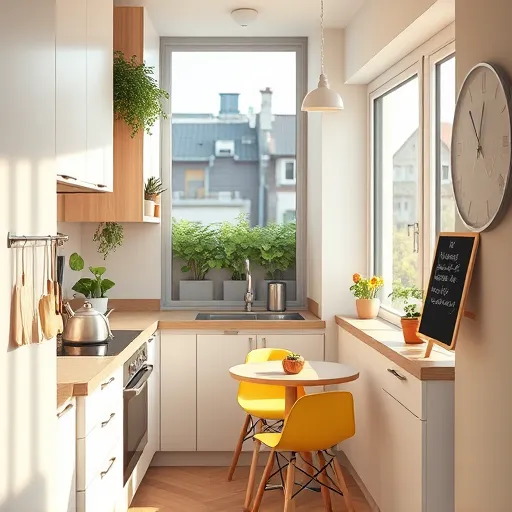
Small Kitchen Layout Optimization Tips for Efficient Space Use
How Can You Maximize Space in a Small Kitchen Through Layout Optimization?
Optimizing a small kitchen layout is essential to making the most of limited space while ensuring functionality and aesthetic appeal. The goal is to create a workflow that minimizes movement and makes every inch count. Start by analyzing your current layout to identify bottlenecks and underused areas. Incorporate vertical storage solutions such as wall-mounted shelves and hanging racks to free up counter space. Consider using multi-functional furniture, like fold-down tables or sliding countertops, to adapt to different needs. For example, a well-planned kitchen cabinet repair can restore functionality and make tailored storage possible.
What Are The Best Layout Configurations for Small Kitchens?
Choosing the right layout is pivotal in small kitchen optimization. The three most effective configurations are:
Single Wall Layout: Ideal for very compact spaces. All appliances and cabinets are aligned along one wall, providing an open feel while freeing up floor space.
Galley Kitchen: Features two parallel countertops, creating a corridor for movement that improves efficiency, especially in narrow spaces.
L-Shaped Design: Utilizes two adjacent walls, offering ample workspace and the potential for a small dining area. This layout supports a natural workflow and maximizes corner space.
Consider consulting with professional designers, like those featured here, to identify the best layout for your specific space and needs.
How Can Smart Storage Solutions Enhance Small Kitchen Layout Optimization?
Storage is often the biggest challenge in small kitchens. Implementing smart storage solutions not only declutters your space but also boosts functionality. Techniques include:
Installing pull-out shelves inside narrow cabinets to maximize inaccessible corners.
Using magnetic strips for knives and metal utensils, freeing up drawer space.
Adding under-cabinet hooks for mugs, cooking tools, or hand towels.
Incorporating corner cabinets with lazy Susans to utilize awkward corner spaces efficiently.
Discover more about cabinet solutions and repairs here. Properly optimized storage can be a game-changer in small kitchen layout optimization.
What Are Space-Saving Appliances and Fixtures That Make a Difference?
Choosing the right appliances and fixtures enhances small kitchen layout optimization by reducing clutter and freeing up workspace. Some effective options include:
Compact appliances designed specifically for small spaces, such as slim refrigerators and narrow dishwashers.
Built-in microwave ovens integrated into cabinetry to save countertop space.
Multi-functional appliances like an oven-convection microwave combo or a combination washer and dryer.
Drop-in sinks or water-saving fixtures that maximize utility without taking up precious space.
Product selection plays a critical role in your overall layout strategy. Focus on compact, high-performance options for seamless integration into the small kitchen environment.
How Do You Plan a Traffic Flow That Supports Efficiency in a Small Kitchen?
Efficient traffic flow minimizes unnecessary movement, preventing congestion and boosting productivity. To create an optimal flow:
Align the work triangle — the stove, sink, and refrigerator — in a way that movement between these zones is direct and unobstructed.
Avoid placing large appliances in the pathway, which can create bottlenecks.
Design pathways that are at least 36 inches wide to allow comfortable movement even when multiple people are using the kitchen.
Use strategic placement of cabinets and storage units to keep frequently accessed items within easy reach, reducing time and effort spent searching.
Thinking critically about kitchen remodeling consultation can help you achieve an ergonomic layout that improves overall functionality.
How Can Lighting and Color Choices Improve Small Kitchen Layout Optimization?
Lighting and color profoundly influence the perception of space. Adequate lighting makes your kitchen appear larger and more inviting, while strategic color choices can increase the feeling of openness.
Use layered lighting— ambient, task, and accent—to eliminate shadows and illuminate all corners effectively.
Opt for light hues like whites, creams, and pastels on walls and cabinets to reflect light and create an airy atmosphere.
Incorporate reflective surfaces such as glass backsplashes and high-gloss cabinets to bounce light around the room.
Balancing lighting and color plays a crucial role in small kitchen layout optimization by giving the illusion of a larger, more functional space.
What Are Common Mistakes to Avoid in Small Kitchen Layout Optimization?
Despite the best intentions, some common errors can hinder your small kitchen's efficiency:
Overcrowding the space with too many cabinets or appliances, leading to cramped conditions.
Poorly planned lighting that leaves areas in shadow, reducing visibility and usability.
Ignoring workflow principles, resulting in long or unnecessary routes between key work zones.
Failing to incorporate vertical storage options, missing the opportunity to utilize wall space.
Take time to plan thoroughly and consider professional assessments to avoid these pitfalls. For more detailed guidance, explore financing options that can support a structured renovation project.
How Do You Maintain and Improve Your Small Kitchen Post-Optimization?
Implementation is just the beginning. Continual maintenance and updates keep your small kitchen optimized over time. Consider:
Regularly decluttering and reorganizing storage to account for changing needs.
Upgrading fixtures and hardware to enhance usability and aesthetics.
Repairing damaged cabinets or surfaces promptly (learn how here).
Staying informed about new space-saving solutions and appliances that emerge in the market.
Ongoing attention ensures your kitchen remains functional, efficient, and visually appealing, effectively maintaining results from your initial layout optimization.
Frequently Asked Questions About Small Kitchen Layout Optimization
What Is the Most Cost-Effective Way to Optimize a Small Kitchen Layout?
Strategically reorganizing existing elements and utilizing smart storage solutions often offers the best value. Focus on decluttering, repairing damaged cabinetry, and choosing space-efficient appliances. Upgrading hardware and paint can also refresh the space without significant investment.
How Can I Make a Small Kitchen Feel Larger Without Remodeling?
Enhance natural light, use light colors, incorporate reflective surfaces, and maintain an organized layout. Small decorative elements, such as mirrors or glass cabinets, can also create an illusion of space.
What Are the Best Tools To Design a Small Kitchen Layout?
Utilize digital planning tools like room planners and design apps that allow you to experiment with different configurations. Consulting with professional designers can offer personalized insights and solutions tailored to your space.
Can Small Kitchen Layout Optimization Increase Property Value?
Yes, a well-designed, efficient kitchen is a significant selling point. Proper layout optimization improves usability and aesthetic appeal, making your home more attractive to buyers.
How Long Does a Small Kitchen Renovation Usually Take?
The timeline varies depending on the extent of changes, but a typical small kitchen renovation can range from a few weeks to a couple of months. Proper planning and professional execution ensure timely completion.
By applying these practical tips and insights, you can transform your small kitchen into a highly functional, aesthetically pleasing space that meets your everyday needs. For expert guidance on your next renovation project, consider reaching out to First Impressions Construction, specialists in kitchen optimization and remodeling.

